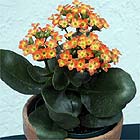Plant Profiles
Click on the first letter of the common name of the plant you wish more information about.
A | B | C | D | E | F | G | H | I | J | K | L | M | N | O | P | Q | R | S | T | U | V | W | X | Y | Z
K

Kaffir Lily
Scientific Name: Clivia miniata
Growth Habit: A bulblike evergreen perennial with dark green, 2-inch-wide leaves originating from near the ground and growing to 2 feet tall.
Light: Shade to filtered sun.
Feedings: Lightly scatter a general garden fertilizer every 6 to 8 weeks spring through early summer. Feed container plantings monthly March through August.
Water Needs: Drought tolerant; grows best with weekly waterings during late winter and spring.
Ease of Culture: Easy.
Propagation: Seed or division.
Hardiness: Tender; survives light frosts; needs protection from freezes.
Major Problems: Kaffir lilies have different flowering habits. Choose one that produces the blooms near the top of the foliage. Keep moist spring through early summer. Grow in a dry, well-drained soil to prevent root rot. Mealybugs and scale insects can affect foliage; control with soap or oil sprays.
Pruning: Remove declining leaves and cold-damaged foliage as needed. Prune flower stalks as the blossoms fade, or leave them to produce seeds.
Uses: Add to the shady garden or patio as an in-ground or container planting. Lilies usually produce bright orange blossoms during March or April. A yellow selection also is available. Grow individually or set several 12 to 18 inches apart.
Florida Native: No; native of South Africa.

Kalanchoe
Scientific Name: Kalanchoe blossfeldiana
Growth Habit: An upright to rounded succulent perennial growing to 12 inches tall. The leaves are thick and oval to oblong with rounded, toothed edges growing to 3 inches long and wide.
Light: Plant in full sun to light shade in landscapes and keep in bright light in the home. Plant in full sun tend to develop a pinkish-colored foliage.
Water Needs: Drought tolerant; best watered when the soil dries.
Feedings: Indoors apply a 20-20-20 or similar fertilizer solution monthly March through October; none during the cooler months. In the landscape, feed lightly every other month during warm weather with a general garden fertilizer.
Propagation: Start plants with cuttings.
Ease of Culture: Easy.
Hardiness: Tender; protect from frosts and freezes.
Major Problems: Plant in a well-drained soil and avoid overwatering to prevent root-rot problems. Plants also may be affected by mealybugs that feed at the base of the leaves and in buds. Wash away mealybugs with a soapy solution.
Pruning: Remove faded flower stems as needed. Also trim plants in late summer to encourage growth. Clippings can be used for cuttings. Pinch out the ends of new shoots several times during the summer to encourage branching. Use: Kalanchoes are often enjoyed as gift plants during the Christmas season and at other times of the year. They naturally open starlike clusters of red, yellow, orange or lavender blossoms December through April, but can be forced into bloom as needed by nurserymen. The plants also can be planted as annual flowers in beds or container gardens for the cooler months. Gardeners often add their gift plants to perennial flower beds after the holidays.
Florida Native: No; native to Madagascar.

Knock Out Rose
Scientific Name: Rosa hybrid
Growth Habit: A rounded evergreen perennial shrub rose growing to 5 feet tall and wide. The leaves are bright green, grow to 5 inches long and 3 inches wide, and are composed of three to seven leaflets.
Light: Plant in a full-sun location.
Feedings: Apply a general garden fertilizer every other month February through November.
Water Needs: Tolerates short periods of drought; grows best with weekly waterings.
Ease of Culture: Easy.
Propagation: A hybrid rose normally propagated by grafting onto a Florida root stock.
Hardiness: Hardy.
Major Problems: Few; not susceptible to the common black spot and mite rose problems. Plant in a well-drained site to avoid root rot. Remove declining stems as needed to prevent dieback.
Pruning: Shrub roses are pruned as needed to maintain the desired shape and size plus remove faded blossoms. Major pruning is normally reserved for mid-February when the shrubs are reshaped and reduced in size to begin spring growth.
Uses: An almost carefree selection for the rose garden. Plants are constantly in bloom, opening clusters of reddish single flowers. Plantings can be featured as an accent, colorful space divider and backdrop for flower beds. Knock Out also can be grown in containers for patio gardens and balconies.
Florida Native: No; a hybrid.

